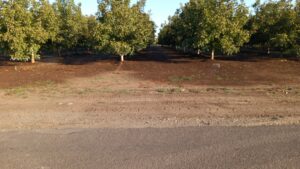by Richard Roth
posted Oct. 27
Adaptive agriculture is one of the greatest tools humans have for solving the problem of global warming. A big ticket — true, but in an age where cow burps and farts have become the vapor of hot debates all around the world, it is time to take a reflective examination of the “what, when, how, where, and who” of natural resource management in our homes and greater communities. And then encourage implementation of corrective adaptation quickly.

In a time of radical climate change, we must consider radical change in land use management when considering such things as formation of the Tuscan Water District.
There are 336,000 acres of deciduous fruit and nut crops in the Sacramento and Feather River watersheds. In the photo below, we see a typical orchard in winter on the very edge of the bank of the Sacramento River on Wilson Landing Road. The bank of the river is lush, with fresh, green growth. The orchard, on prime agricultural land, is bare — in the rainy season.

This is due to common practices of the ag-orchard industry in this area. The result is that on land conventionally managed:
•this ground is compacted, so
•a large percentage of rainfall runs off into the river and out to sea,
•depriving the soil profile of its full stock of rainwater to fill its holding capacity, and
•shutting down recharge of our deep water aquifers, while
•water is pumped out of the river or out of the ground to produce nuts, the majority of which are shipped overseas.
There is no vegetative cover or cool-season crops in these orchard monocultures to
•capture carbon,
•produce food, or
•increase or maintain soil fertility, or
•provide habitat for beneficials, but rather alternatively
•provides petri dishes on a grand scale for pathogens, and soil depletion
•that then demands petrochemical-intense interventions to maintain the system.
There are established alternatives with expert assistance available — locally and for free — for farmers ready to adapt to modern natural resource needs. These free resources are available through the local county resource conservation districts (RCDs). To increase availability to these local services, several RCDs have joined in collaborative agreements with neighboring counties to share cross-county border equipment and expertise.
I, for one, have been particularly impressed with the work being done by the Glenn and Butte County RCDs. We are also blessed to have Chico State’s Center for Regenerative Agriculture and Resilient Systems, that besides educating young people to lead the way, also offers many — many — public events and resources, many of them free and available online. These resources can not only point us toward the ‘how’ — they can point us to the ‘why’!
When I was born, the parts per million (ppm) of CO2 in the atmosphere stood at 312, just 32 ppm more than the fairly stable 280 ppm for the previous million years. Standing now at 416 ppm means that three-fourths of the damage humans have inflicted to the atmosphere has been done in my own lifetime!
Half of that damage has been done in the last 36 years.
We have changed the Earth into a planet increasingly alien to us. The bright side is: Because Humans made it, Humans can unmake it.
We can bring CO2 levels back down to sustainable levels, but we are running out of time. My own conclusion is that the work of correcting the damage done has to be completed as fast or faster than the time we took to create it. In other words, we need to halve the damage in the next 36 years or faster, and most of that correction needs to happen in the next 10. That demands the complete overhaul of just about everything involving established human culture, down to and including the use of cover crops in nut orchards. On a global scale, there is no debt relief for carbon footprints.
I am 70 years old now. I had an aunt who lived to be 104. If I could live to see CO2 levels in the atmosphere reduced to the same level as when I was born — wouldn’t that be lovely? Can it be done? It is young people and the existing farmers and farming and natural resource organizations that can turn this around if supported, guided and encouraged by a civil, educated, reflective and concerned public.
What was the CO2 level when YOU were born? And how many years do you calculate we have to get there?
Richard Roth has a degree in plant and soil science from Chico State University and has farmed most of his life, in both Kansas and California.

Thank you so much for this sobering yet hopeful reminder that we have options available to both improve the environment and maintain a healthy agricultural economy.